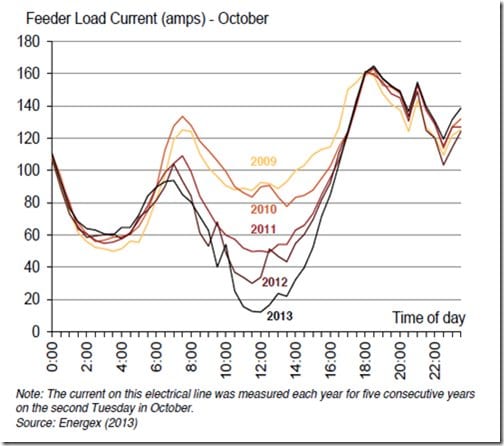Australia is unusual in the fact that more than 50% of electricity bills are related to network costs.
The big issue is that networks must be built to handle the highest load of the year. The development of solar panels means that the generation in the middle of the day is reducing the average load, while the peak demand is largely unchanged.
We need to develop a process to encourage load peaks to reduce.
In the figure below for a feeder in Caloundra the midday load is reducing as solar power levels increase but the evening peak is almost unchanged. Automated use of batteries and demand shifting is the main hope for addressing the peak demand issue.
The problem at the moment is that the electricity tariffs provide no incentive to residential premises to reduce the peak.
However, create a market and the solutions will be found.
There have been proposals for a high charge for the 4 hours around the evening peak and a medium charge for another 4 hours adjacent to that. The problem with this crude form of incentive is that it is not reflective of any real network constraint. If the real peak lasts 1 hour then increased charging for a longer time makes some solutions less viable. Similarly, if the time of peak shifts to 10pm the tariff is creating a new problem rather than actually reducing the peak.
The appropriate charge is to reflect the long run real cost of supplying the loads.
The wrong way
If the price charged for electricity jumps by a factor of 10 at 6:15pm on some nights, all it does is to annoy customers with no real possibility of maintaining changes in the use of lights and TV for the long term.
The right way
What a real cost-reflective tariff should incentivise is automatic control of items such as pool pumps, hot water systems, clothes dryers and batteries to limit the draw at peak times. The response can be within parameters set by the customer possibly responding to signals sent about network congestion.
Location matters
For some areas there is not a congestion problem and the charges should reflect the ownership cost of the poles and wires. In other areas the peak load growth can be driving substantial network costs and it is these areas where a cost reflective pricing would drive investment in batteries and peak load reduction through automated responses.
Why change?
The current scheme is potentially on a path to a “Death Spiral” where increasing network costs encourage some customers to buy batteries and go “off-grid”. This raises the network costs for remaining customers, which incentivises a new wave of customers to go “off-grid”.
Introducing true cost reflective pricing will provide a reward for customers with batteries to stay on-grid.
Winners and Losers
The costs for rural customers could rise substantially but other parts of the social security/tax system are a better mechanism to encourage right decisions than highly subsidized electricity bills.
How it might work
One option for the future is given in the figure below, which shows aggregators responding to the real costs and making a market arrangement with customers to make load variations in line with network needs.
Professor Gerard Ledwich has been at QUT since 1999 and is currently Discipline leader for Power Engineering as well as Theme Leader in the Institute for Future Environments.










